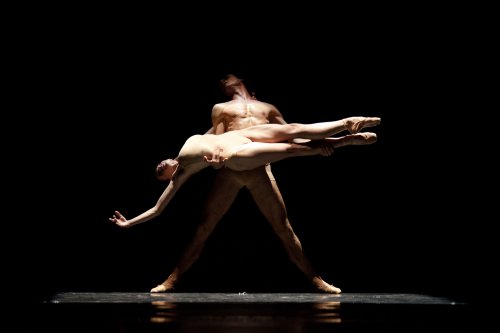Polish National Ballet 2015
A European ballet troupe shows its contemporary side.

Adam Kozal and Aneta Kbrzezniak of the Polish National Ballet in a scene from Krzysztof Pastor’s “Moving Rooms” (Photo credit: Ewa Krasucka)
[avatar user=”Joel Benjamin” size=”96″ align=”left” ] Joel Benjamin, Critic[/avatar] The Polish National Ballet brought a contingent of twenty-three dancers for their engagement at the Joyce Theater, representing less than a third of the troupe. For some reason, artistic director Krzysztof Pastor also left behind the company’s classical works and brought only three modern ballets even though there are many classical works that can be danced by two, three or four dancers.
Judging from this program only, the PNB is firmly in the mainstream of the world’s modern ballet troupes, almost indistinguishable one from the other (viz. Netherlands Dance Theater, Sydney Dance Theater, National Ballet of Spain, Houston Ballet, etc.) Mr. Pastor’s ballets are part and parcel of the international ballet style which I like to call “fun house ballet,” in which classical ballet steps and poses melt into twisty, angular shapes only to coalesce into and be punctuated by recognizable classical vocabulary. William Forsythe, a real iconoclast, began this in his purposely ugly “in the middle somewhat elevated.” The watered-down copies permeate the repertories of many dance companies.
The better of Mr. Pastor’s two contributions to the program was “Adagio & Scherzo” to a Schubert String Quintet. The eight dancers, dressed in chic black and grey practice outfits, began in and kept returning to a circular sculptural grouping dead center in which the dancers assumed interlocking poses. As the slow music began the tight-knit assemblage opened into multiple duets which displayed the dancers’ high extensions, twisty lifts, sudden dips to the floor and quicksilver point work. Pastor wittily used split-second dips into “six o’clock” penchées for their gasp-inducing effect. As the music sped up, duets melted into larger groups and the mood became definitely lighter. The ballet had too many false endings, diluting its overall effect.

Adam Kozal, Patryk Walczak and Kurusz Wojenski of the Polish National Ballet in a scene from Krzysztof Pastor’s “Moving Rooms” (Photo credit: Ewa Krasucka)
In “Moving Rooms,” a strangely dark choice to end a program, to dreary music by Alfred Schnittke and Alfred Schnittke, Pastor repeated his conceit of beginning in and returning to a symbolic stage picture, in this case each dancer ensconced in a single square of chessboard-patterned light. Every choreographer has a “calling card” and this seems to be Pastor’s, his way to apply a feeling of structure. The end effect was of an agitated community that kept returning to their little lonely rooms. Unexplained angst reigned. Pastor’s decision to end his program with such a dark ballet is questionable.
The most original ballet was Emanuel Gat’s “Rite of Spring” to the famous Stravinsky score. His approach was to ignore the original scenario and its progeny: a community, be it ancient or modern, gets together to isolate and sacrifice a maiden (innocent man, child, duo, etc.) who is forced to dance to death to the pounding rhythms of the finale. Mr. Gat instead took five dancers, dressed in dark street clothes (designed by himself) and made them repeat—and repeat and repeat—a musical chairs style ballroom dance—resembling a slow Lindy Hop—in which one woman is always left out. A red rug in the center of the stage defined the limits of the dreary ballroom in which these people soullessly partnered each other. At several moments, two of the dancers stalked off into the murk at the edges of the stage. Although his was a good effort, Mr. Gat was ultimately defeated by the magnificence of the music which made his choreographic efforts look puny. The dancers, brilliantly agile here and throughout the program, did him proud, though.
The lighting throughout the show was too dark which was sometimes effective, sometimes irritating. Also Mr. Pastor seems to be among the legions of choreographers who feel it necessary to over-explain their ballets. Forget the words, guys. A simple sentence or two or a great, pithy title is all that is needed … plus great choreography, of course!
Polish National Ballet (June 16-21, 2015)
Joyce Theater, 175 Eighth Avenue, in Manhattan
For tickets, call 212-242-0800 or visit http://www.joyce.org
For more information: visit http://www.teatrwlelk.pl
Running time: one hour and 45 minutes including two intermissions






Leave a comment